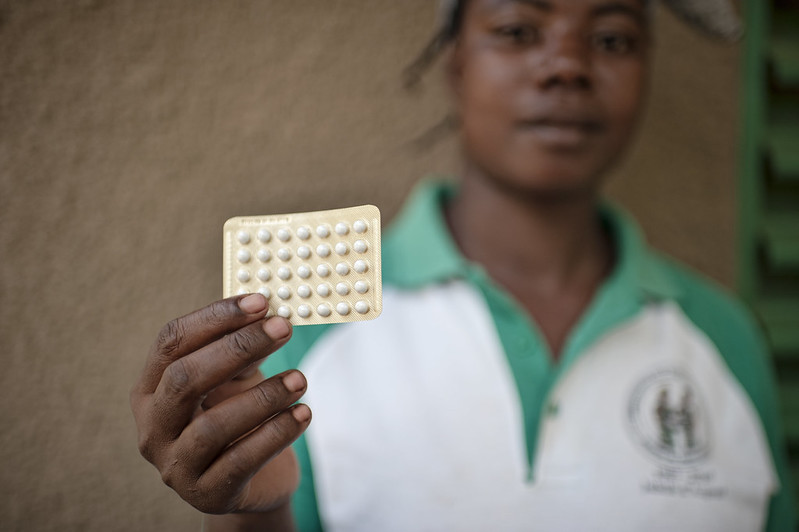Sexual and reproductive health advocates need to hold the Biden-Harris administration and congressional lawmakers accountable to undo the harms of the last four years, push for progressive and equitable policies, and make 2021 a turning point for sexual and reproductive health, rights and justice.

This article was first published on Nov. 10 by the Guttmacher Institute. Written by Leah H. Keller, Adam Sonfield, Megan K. Donovan, Ruth Dawson and Zara Ahmed.
President-Elect Joe Biden and Vice President-Elect Kamala Harris will take office in January 2021, having received a record-shattering number of votes nationwide, alongside a Democrat-led U.S. House of Representatives and a Senate with a razor-thin majority that is yet to be decided.
Though many are celebrating the end of the Trump administration and the beginning of Democratic control of the White House, new leadership does not guarantee that sexual and reproductive health care and rights will be fully available to all.
Advocates need to hold the incoming administration and congressional lawmakers accountable to undo the harms of the last four years, push for progressive and equitable policies, and make 2021 a turning point for sexual and reproductive health, rights and justice. They must also be vigilant for any harmful or restrictive policies that may be enacted in the period between the election and inauguration.
When the Biden administration enters office, it will have been nearly a year since COVID-19 began to push the fragmented U.S. health care system to its limits. During this time, sexual and reproductive health and rights were neglected or outright targeted by the Trump administration and other opponents of reproductive autonomy.
Moving forward, the focus for advocates and policymakers cannot simply be on how to restore the health care system to its pre-pandemic status, but rather on how to redress long-standing injustices and bolster sexual and reproductive health and rights. In particular, advocates and lawmakers must prioritize the needs of the marginalized communities who bore the brunt of the Trump administration’s attacks.
With this resource, we lay out recommendations for Congress and the executive branch to meet the needs of communities and populations that will be most affected by sexual and reproductive health policy decisions that lie ahead, based on the latest evidence and rooted in values of equity and justice.
Who Will Be Impacted by Sexual and Reproductive Health Policy Decisions in 2021?
Anyone who uses public health insurance programs or the Affordable Care Act
Where things stand now: Conservative policymakers have repeatedly attempted to weaken Medicaid, although most states have expanded eligibility for full-benefit Medicaid coverage or family planning services. The Trump administration has undermined the Affordable Care Act (ACA), and a U.S. Supreme Court case threatens all of the law’s many gains for sexual and reproductive health.
Why this is important: More than 20 percent of all women and nearly half of low-income women aged 15–44 rely on Medicaid and other public health insurance programs for coverage. The ACA protects patients against unfair insurance practices and has greatly expanded the scope of Medicaid and private health insurance plans, requiring coverage of contraceptives, maternity care and many other reproductive health services.
How to move forward
- Administration: Halt and reverse the Trump administration’s attempts to undermine Medicaid and the ACA, incentivize states to expand Medicaid (if they have not done so already) and affirm Medicaid enrollees’ right to see the provider of their choice.
- Congress: Increase access to affordable, comprehensive insurance in all states, such as by approving Biden’s plan for a public health insurance option. Take any necessary steps to preserve the ACA, if the Supreme Court strikes it down in whole or in part.
Anyone who uses contraception
Where things stand now: The Trump administration and an increasingly conservative judiciary have made it easier for employers and schools to deny insurance coverage for contraceptives and undermined the Title X national family planning program through the “domestic gag rule,” which cut the network’s patient capacity in half.
Why this is important: Forty-three million women in the United States are sexually active and do not want to become pregnant. Title X focuses its services on underserved and vulnerable populations: As of 2019, one-quarter of its patients are Black and one-third are Hispanic, and two-thirds of its patients have incomes at or below the federal poverty level.
How to move forward:
- Administration: Close loopholes in the ACA’s contraceptive coverage guarantee, eliminate the Trump administration’s sweeping religious and moral exemptions to the guarantee, and repair the Title X program by reversing the domestic gag rule and rebuilding the network by allowing long-standing providers back into the program.
- Congress: Dramatically increase funding for the Title X program.
Anyone seeking an abortion
Where things stand now: Six in 10 women live in states with policies that are hostile toward abortion rights, and the federal Hyde Amendment and related bans block insurance coverage of abortion for millions of people who obtain their health coverage or care through federal programs, including Medicaid and Medicare enrollees, federal employees, military personnel and veterans, federal prisoners and detainees, Native Americans, Peace Corps volunteers and low-income residents of the District of Columbia.
Why this is important: One in four women will have an abortion in their lifetime, yet many face substantial financial and logistical barriers to abortion care.
How to move forward:
- Administration: Demonstrate and vocalize a clear commitment to abortion rights and equitable access. Condemn anti-abortion violence and intimidation and dedicate resources to response and prevention. Rescind the 2010 executive order that reinforces the Hyde Amendment and direct all departments and agencies to rescind harmful policies and regulations related to abortion coverage and access. Review U.S. Food and Drug Administration restrictions that limit access to medication abortion, including through telehealth.
- Congress: Lift the Hyde Amendment and related abortion coverage bans. Pass the Equal Access to Abortion Coverage in Health Insurance (EACH Woman) Act to restore public insurance coverage of abortion and the Women’s Health Protection Act to create a federal statutory right to access abortion without medically unnecessary restrictions.
Anyone who will need maternal health care

Where things stand now: Black and Indigenous women’s maternal mortality rates are two to three times the rate as those of White women, and four to five times as high among older age groups. The federal government has not offered a comprehensive response to the growing maternal health crisis, but nearly all states have maternal mortality review committees to understand and address the causes of preventable maternal deaths.
Why it matters: The U.S. has the highest maternal mortality rate among developed countries, with dramatic racial disparities that are preventable and caused by systemic racism and provider bias.
How to move forward:
- Administration: Address racism as a public health crisis that shapes maternal health and allow states to expand Medicaid and Children’s Health Insurance Program (CHIP) coverage to at least 12 months postpartum.
- Congress: Pass the Black Maternal Health Momnibus Act, and increase funding for the Title V maternal and child health services block grant, Safe Motherhood and Infant Health Initiative and the Surveillance for Emerging Threats to Mothers and Babies initiative.
Immigrants
Where things stand now: The Trump administration has expanded xenophobic policies in several ways, including through the public charge rule. The policy was designed to create fear and confusion in immigrant communities and has resulted in some people avoiding publicly funded programs that they are eligible to use (e.g., Medicaid).
Why this is important: Immigrant women are less likely to have health insurance coverage and use sexual and reproductive health services than U.S.-born women, which may increase their risk of negative health outcomes.
How to move forward:
- Administration: Repeal the expanded public charge rule and regulations excluding Deferred Action for Childhood Arrivals recipients from benefits under the ACA. Prohibit the U.S. Department of Homeland Security from detaining pregnant or postpartum people and parents, and require protection of detainees against reproductive coercion. Incentivize states to expand Medicaid and CHIP coverage for immigrants.
- Congress: Pass the HEAL for Immigrant Women and Families Act.
Adolescents and young adults
Where things stand now: Young people face confidentiality concerns and logistical barriers to obtaining sexual and reproductive health care, and the Trump administration has aggressively pushed for abstinence-only sex education.
Why this is important: By age 25, 93% of people will have had sex, and the COVID-19 pandemic will have profound and likely lasting impacts on this generation’s sexual and reproductive health.
How to move forward:
- Administration: Support congressional efforts to redirect abstinence-only funding to comprehensive and other sex education programs.
- Congress: Pass the Real Education for Healthy Youth Act to end federal funding of abstinence-only education and fund comprehensive sex education programs. Pass the Youth Access to Sexual Health Services Act to support sexual health care access for marginalized young people. Eliminate abstinence-only sex education programs and redirect the money to the Personal Responsibility Education Program and Teen Pregnancy Prevention Program.
LGBTQ community
Where things stand now: The Trump administration has weakened a key antidiscrimination policy in the ACA and made it easier for health care providers and institutions to refuse care to LGBTQ patients.
Why this is important: LGBTQ people already face discrimination in the health care system and stigmatizing sex education. During the COVID-19 crisis, they have faced disproportionate delays and challenges in obtaining contraceptives and gender-affirming care.
How to move forward:
- Administration: Fully restore the ACA’s antidiscrimination protections, reverse the refusal of care rule, and ensure that all federally funded sex education is LGBTQ inclusive.
- Congress: Ensure that health care reform and other sexual and reproductive health legislation supports LGBTQ people’s bodily autonomy.
Black, Indigenous and other people of color
Where things stand now: The U.S. government has a long history of dictating and coercing the reproductive health decisions of Black, Indigenous and other people of color that continues today through policies that threaten vital health services and criminalize people’s actions and outcomes during pregnancy.
Why this is important: The maternal mortality rate for Black women nationally is 3.2 times the rate for White women, and racist policies like the Hyde Amendment are designed to target people with low incomes—and, in particular, people of color—for harmful and discriminatory treatment.
How to move forward:
- Administration: Acknowledge racism as a cause of heath disparities, address the disproportionate impact of the COVID-19 pandemic on communities of color, incentivize states to increase Medicaid eligibility, and bar the U.S. Department of Justice from criminalizing self-managed abortion, substance use during pregnancy, and other pregnancy-related behaviors or outcomes.
- Congress: Eliminate the Hyde Amendment and expand access to affordable health insurance coverage.
People around the world
Where things stand now: Millions of people depend on U.S. foreign assistance programs to access sexual and reproductive health services. The Trump administration has tried to decrease funding for this work, pulled U.S. support from the World Health Organization (WHO) and the United Nations Population Fund (UNFPA), and put up barriers to the provision of comprehensive care, including for safe abortion services.
Why this is important: Across 132 low- and middle-income countries, more than 218 million women of reproductive age have an unmet need for contraception and more than 35 million unsafe abortions occur each year.
How to move forward:
- Administration: Issue executive order repealing the “global gag rule,” rejoin and restore funding to WHO, restore funding to UNFPA, and champion sexual and reproductive health and rights on the global stage.
- Congress: Appropriate the full U.S. fair share of funding for international family planning and reproductive health programs ($1.66 billion per year), pass the Global Health, Empowerment and Rights (Global HER) Act to permanently repeal the global gag rule, pass the Support UNFPA Funding Act to reinstate funding for UNFPA programs, repeal the Helms Amendment to end the ban on U.S. funding for safe abortion internationally, and increase funding to multilateral organizations and all global health programs.
You may also like:





